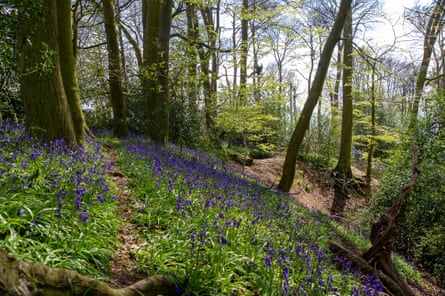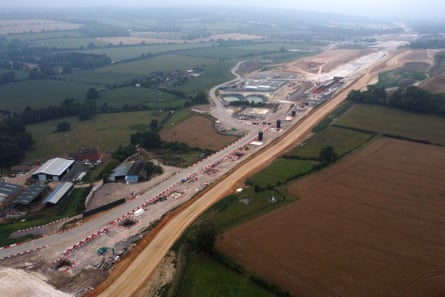Margaret Bunce used to look from her cottage window over a swoop of fields of wheat and small copses. Now when she opens her curtains each morning, the rural valley between Great Missenden and Wendover is dominated by the concrete and earthworks of HS2.
Orange-clad men and their yellow diggers and dumpers are building cuttings and viaducts to take the high-speed railway on its path through a swath of the Chilterns area of outstanding natural beauty (AONB), now known as a national landscape.
The railway from London to Birmingham is Britain’s biggest building site, a linear stretch of earthworks almost 140 miles long including tunnels, much of it visible on Google Maps’s satellite view as a vivid beige scar down the middle of England.
Combining satellite imagery with additional research, the Guardian calculates that the green space lost to the HS2 development within the national landscape amounts to 252 hectares.
In the coming years, once the groundworks are complete, much of this devastation will be regreened. Construction compounds, temporary car parks and temporary factories will be dismantled and the land rehabilitated. But this part of the Chilterns national landscape is irrevocably changed.
“It’s cruel. It’s disgusting,” Bunce says. Born in a nearby village when this was a sleepy, leafy corner of Buckinghamshire, she is a farmer’s daughter now married to a farmer. “If my father or father-in-law came back, they wouldn’t believe it, any of them,” she says.
Grandpy Bunce began farming here in 1933. If the name sounds familiar, Bunce the farmer crops up in Fantastic Mr Fox: Roald Dahl, who was a local resident, borrowed their surname for one of the dastardly characters in his much-loved children’s book.
The fictional Bunce dug out a hill in pursuit of Mr Fox. Over the last five years, the real-life Bunces have watched HS2 doing rather more in the valley of the Misbourne chalk stream.
“It’s been beyond difficult,” says Peter Bunce, Margaret’s husband. “The last six months have been hell.” He wishes he had sold the farm before construction began.
While most of the Chilterns national landscape has been spared by a 10-mile tunnel through the chalk, the line bursts out of the ground at South Heath and tracks up the valley between Great Missenden and Wendover for just over four miles.
Locals lodged 344 formal petitions with parliament for the tunnel to be extended as far as Wendover but were told it would be too expensive. Instead, the railway is above ground up the valley, within a 14-metre-deep cutting section and over two viaducts. When it passes Wendover it will enter a 0.9-mile “green tunnel” placed in a deep cutting, which will then be landscaped over, says HS2, with a mix of grassland and woodland.

HS2 has taken 6.5 hectares (16 acres) of the Bunces’ land and, like many farmers along the route, they now find their fields inconveniently divided by the line. Of the lost area, 3.5 hectares were taken on “temporary possession” by HS2, meaning the land could be returned – after some years – to the landowner (although HS2 can still decide to compulsorily purchase it at a later date). HS2 has planted trees on the land it has “temporarily” taken from the Bunces, making it greener, to offset losses elsewhere, but also making the land more difficult to farm again.
The most high-profile loss of greenery on this section was the destruction of more than a third of Jones’ Hill Wood, a 1.8-hectare fragment of ancient woodland. Campaigners built treehouses in the wood in 2021. A challenge to the legality of the wood’s destruction, relating to its rare barbastelle bat roosts, reached the high court but HS2 prevailed.
Another loss was 75 metres of Grim’s Ditch, an iron age monument running through the Chilterns. Although this was less than the 150 metres originally planned, Buckinghamshire council said it “bitterly regretted” the destruction.

Residents are troubled not only by the loss of ancient landscape features or the peaceful, green view, although the valley does also contain pylons and the busy A413 road. Years of construction are taking their toll.
Roger Turner lives 300 metres from where the line bursts out of the Chilterns. His farm is divided, with most of his 52 hectares on the other side of the tracks from his farmhouse. The trains will run 14 metres below his house, in a cutting. “We won’t see it but we’ll hear it,” he says. “But I might be deaf by the time the trains are running.”
During the groundworks, Turner says, the disruption caused flash floods where there never used to be flooding. Water ran on to his fields. Now the cutting has been dug, he says, the water runs into there instead. His sister Sarah Turner says that during heavy rain “the ditches run with water – and it’s not clear water”.
Roger says: “Initially I thought we could live with it. We had no idea of the impact of the lorries. I’d recommend to anybody near an infrastructure project – get out of it.”
According to HS2, apart from a strip approximately 19 metres wide (narrower than a typical motorway of three lanes each way), everything will be greened over. Through the Chilterns national landscape only 795 metres of the railway will be visible – the two viaducts – with the rest of the track in a tunnel or cutting.

HS2 has created 4.1 hectares of new woodland directly linked to Jones’ Hill Wood and 20 hectares of new woodland across the whole of the Chilterns, using mixes of native broadleaved species. In some places it has translocated ancient woodland soil, speeding up the creation of new woodland.
A spokesperson said: “Land alongside the railway will either be returned to farmers, landscaped to form false embankments (to cut noise) or used to create new wildlife habitats. Where the railway is in a cutting, the sides of the cutting will be covered in grass, which may not be glamorous but is valuable for wildflowers and invertebrates.”
On the issue of flooding, HS2 pointed out it had created large “attenuation ponds” that capture run-off during heavy rainfall and slowly feed the filtered water back into natural watercourses over the following weeks. “The capacity of the system is designed to manage normal heavy rainfall and we have the correct EA [Environment Agency] consents in place,” the spokesperson said.
HS2 also noted that flooding on the A413 in the valley had been a longstanding problem, predating HS2, and was the responsibility of the local highways authority.
The earthworks stage of HS2 – peak destruction – is scheduled to finish in the Chilterns in 2027. Experts predict the much-delayed high-speed railway will not open until years after its scheduled 2033 completion date.
Some nearby residents sold up to HS2 and moved away. Many who stayed in the Misbourne Valley are desperate for the building work to end and still struggling to accept the daily disruption to their routines – from road closures to dust or weed seeds blowing from the earthworks – and their drastically changed landscape.
“We’ve got to live with it now,” says Margaret Bunce. “We can’t do anything about it. Pete was born in this house. Took over the farm when he was 13 because his dad died of a stroke. He’s got a bit turned off farming now. If it wasn’t for our son, his heart has gone.”
The Guardian’s Green to Grey team includes Pamela Duncan, Zeke Hunter-Green, Tural Ahmedzade and Sandra Laville with additional reporting by Rachel Keenan, Raphael Boyd, Olivia Lee, Yassin El-Moudden, Gracie Daw, Matthew Holmes, Mariam Amini, Gabriel Smith, Dominic Kendrick and Emma Russell
For more, visit greentogrey.eu
The next phase of this project will be planet-wide: join a crowdsourced citizen science initiative to measure global nature loss here

 2 months ago
47
2 months ago
47

















































